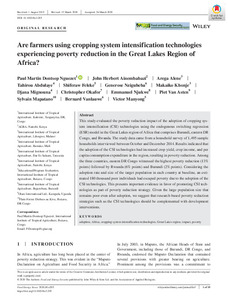| dc.contributor.author | Dontsop Nguezet, P. M. |
| dc.contributor.author | Ainembabazi, J.H. |
| dc.contributor.author | Alene, A. |
| dc.contributor.author | Abdulaye, T. |
| dc.contributor.author | Feleke, S. |
| dc.contributor.author | Nziguheba, G. |
| dc.contributor.author | Khonje, M. |
| dc.contributor.author | Mignouna, D. |
| dc.contributor.author | Okafor, C. |
| dc.contributor.author | Njukwe, E. |
| dc.contributor.author | van Asten, P. |
| dc.contributor.author | Mapatano, S. |
| dc.contributor.author | Vanlauwe, B. |
| dc.contributor.author | Manyong, V. |
| dc.date.accessioned | 2022-04-21T09:09:00Z |
| dc.date.available | 2022-04-21T09:09:00Z |
| dc.date.issued | 2020-08 |
| dc.identifier.citation | Dontsop Nguezet, P. M., Ainembabazi, J. H., Alene, A., Abdulaye, T., Feleke, S., Nziguheba, G., ... & Manyong, V. (2020). Are farmers using cropping system intensification technologies experiencing poverty reduction in the Great Lakes Region of Africa?. Food and Energy Security, 9(3): e205, 1-19. |
| dc.identifier.issn | 2048-3694 |
| dc.identifier.uri | https://hdl.handle.net/20.500.12478/7425 |
| dc.description.abstract | This study evaluated the poverty reduction impact of the adoption of cropping system intensification (CSI) technologies using the endogenous switching regression (ESR) model in the Great Lakes region of Africa that comprises Burundi, eastern DR Congo, and Rwanda. The study data came from a household survey of 1,495 sample households interviewed between October and December 2014. Results indicated that the adoption of the CSI technologies had increased crop yield, crop income, and per capita consumption expenditure in the region, resulting in poverty reduction. Among the three countries, eastern DR Congo witnessed the highest poverty reduction (13% points) followed by Rwanda (6% points) and Burundi (2% points). Considering the adoption rate and size of the target population in each country at baseline, an estimated 180 thousand poor individuals had escaped poverty due to the adoption of the CSI technologies. This presents important evidence in favor of promoting CSI technologies as part of poverty reduction strategy. Given the large population size that remains poor even after adoption, we suggest that research‐based poverty reduction strategies such as the CSI technologies should be complemented with development interventions. |
| dc.format.extent | 1-19 |
| dc.language.iso | en |
| dc.subject | Innovation Adoption |
| dc.subject | Africa |
| dc.subject | Cropping Systems |
| dc.subject | Intensification |
| dc.subject | Technology |
| dc.subject | Poverty |
| dc.subject | Great Lakes |
| dc.title | Are farmers using cropping system intensification technologies experiencing poverty reduction in the Great Lakes Region of Africa? |
| dc.type | Journal Article |
| cg.contributor.crp | Maize |
| cg.contributor.crp | Roots, Tubers and Bananas |
| cg.contributor.crp | Policies, Institutions and Markets |
| cg.contributor.affiliation | International Institute of Tropical Agriculture |
| cg.contributor.affiliation | Alliance for a Green Revolution in Africa |
| cg.contributor.affiliation | Olam International Ltd., Uganda |
| cg.contributor.affiliation | Plate-Forme Diobass au Kivu |
| cg.coverage.region | Africa |
| cg.coverage.region | Central Africa |
| cg.coverage.country | Burundi |
| cg.coverage.country | Democratic Republic of the Congo |
| cg.coverage.country | Rwanda |
| cg.coverage.hub | Southern Africa Hub |
| cg.coverage.hub | Eastern Africa Hub |
| cg.coverage.hub | Central Africa Hub |
| cg.coverage.hub | Headquarters and Western Africa Hub |
| cg.researchtheme | Biotech and Plant Breeding |
| cg.researchtheme | Natural Resource Management |
| cg.researchtheme | Social Science and Agribusiness |
| cg.identifier.bibtexciteid | DONTSOPNGUEZET:2020 |
| cg.isijournal | ISI Journal |
| cg.authorship.types | CGIAR and developing country institute |
| cg.iitasubject | Agribusiness |
| cg.iitasubject | Agronomy |
| cg.iitasubject | Crop Systems |
| cg.iitasubject | Food Security |
| cg.iitasubject | Plant Breeding |
| cg.iitasubject | Plant Production |
| cg.iitasubject | Post-Harvesting Technology |
| cg.iitasubject | Smallholder Farmers |
| cg.iitasubject | Value Chains |
| cg.journal | Food and Energy Security |
| cg.notes | Open Access Journal; Published online: 12 May 2020 |
| cg.accessibilitystatus | Open Access |
| cg.reviewstatus | Peer Review |
| cg.usagerightslicense | Creative Commons Attribution 4.0 (CC BY 0.0) |
| cg.targetaudience | Scientists |
| cg.identifier.doi | https://dx.doi.org/10.1002/fes3.205 |
| cg.iitaauthor.identifier | DONTSOP NGUEZET Paul Martin: 0000-0001-5098-1853 |
| cg.iitaauthor.identifier | John Herbert Ainembabazi: 0000-0001-6700-4522 |
| cg.iitaauthor.identifier | Arega Alene: 0000-0002-2491-4603 |
| cg.iitaauthor.identifier | Tahirou Abdoulaye: 0000-0002-8072-1363 |
| cg.iitaauthor.identifier | Shiferaw Feleke: 0000-0002-0759-4070 |
| cg.iitaauthor.identifier | Generose Nziguheba: 0000-0003-4227-2242 |
| cg.iitaauthor.identifier | Djana Babatima Mignouna: 0000-0002-4074-2928 |
| cg.iitaauthor.identifier | Chris Okafor: 0000-0003-2162-6101 |
| cg.iitaauthor.identifier | Piet van Asten: 0000-0003-0584-3552 |
| cg.iitaauthor.identifier | bernard vanlauwe: 0000-0001-6016-6027 |
| cg.futureupdate.required | No |
| cg.identifier.issue | 3 |
| cg.identifier.volume | 9 |

